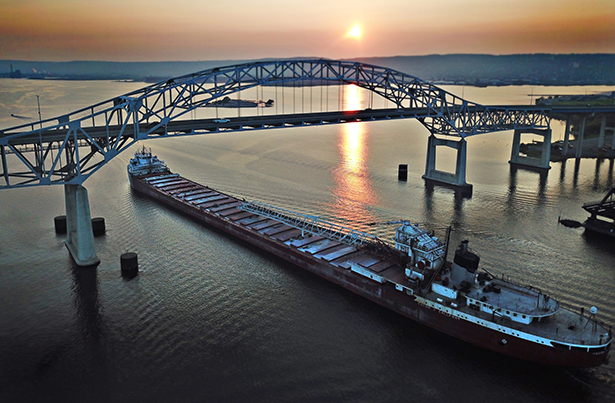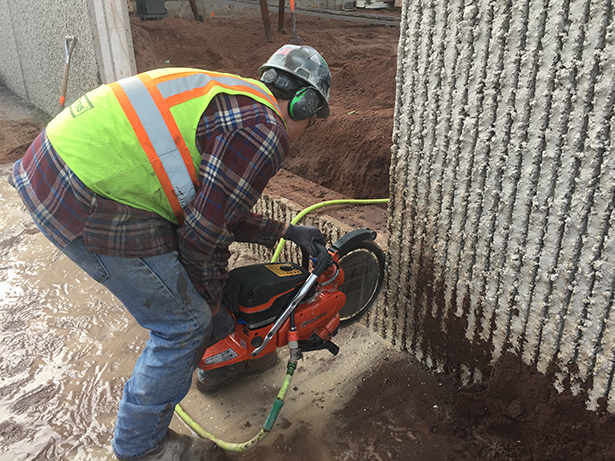
By Patrick Lapinski
The Port of Duluth-Superior is a Driver of More Prosperous Regional, National and International Economies
For Northlanders, it’s nearly a rite of passage to note when the first ship of the year enters and leaves the Duluth-Superior harbor. The beginning of another shipping season reminds us of the port’s importance as a transportation and economic hub.
The most recent economic impact study, released in 2018 and entitled “Economic Impacts of Maritime Shipping in the Great Lakes-St. Lawrence Region,” provides a wealth of data regarding the port’s impact on our community. The information can be broken down into several distinct categories; jobs, revenue impacts, personal income and local consumption impacts, and federal, state and local tax impacts.
Positive numbers are easy to cite, such as the 7,881 jobs supporting the movement of cargo, which drives $299.2 million in “regional purchases by businesses supplying services at the marine terminals at the Port of Duluth-Superior.” This equates to a direct economic impact of $1.4 billion. The 2,814 jobs directly related to cargo handling resulted in the generation of $132.1 million in personal wages and salaries. The purchase of goods and services – the “re-spending effect” – accounted for an additional $240.2 million in income and consumption. State and federal taxes generated $239.6 million during the study’s time period (2017). Those are all impressive numbers. But statistics are, of course, only a part of the story.
In 2017, a complementary study was conducted for the Duluth Seaway Port Authority by The Initiative for a Competitive Inner City
(a nonprofit research and advisory organization founded by Harvard Business School professor Michael Porter) to specifically focus on the industrial sector, not just the maritime sector, in Duluth. This study compared a conservatively estimated 9,500 industrial jobs in Duluth against the rest of the economy, aggregated.
“We advocate for the maritime and transportation industries. In doing so, we look out for both sides of the harbor.”
– Executive Director Deb DeLuca, Duluth Seaway Port Authority
Executive Director Deb DeLuca of the Port Authority says there are several key takeaways from the study’s 2016 data. One is that people with industrial jobs in Duluth have an average annual income of $61,000 per year, which exceeds the region’s nonindustry average annual income by $18,000. Along with those higher wages, industrial jobs also tend to be accessible to a wider range of educational backgrounds, and they offer very competitive benefits, plus strong opportunities for career advancement.
In addition, DeLuca explained, there’s a higher multiplier associated with industrial jobs that have a big impact on a countywide level. “Every 10 jobs in the industrial sector create eight jobs elsewhere in the economy,” she noted, adding that these could be industrial, professional services or hospitality jobs, “whereas if you look at the rest of the economy, every 10 jobs create five jobs. So again, what that means is when the industrial sector grows, the rest of the economy grows. It’s a powerful engine for growth.”
Another key takeaway is that while the rest of the economy may be five times larger on a job number basis or a per job basis, a job in the industrial sector generates three times more local tax revenue per job.
Growth From the Beginning
A quick history lesson on the port’s actual formation: In June of 1896, the 54th Congress of the United States voted into law this portion of the River and Harbors Act: “Making appropriations for the construction, repair, and preservation of certain public works on rivers and harbors, and for other purposes,” and further stipulating that the funds “be expended under the direction of the Secretary of War and the supervision of the Chief of Engineers, for the construction, completion, repair, and preservation of the public works herein after named.”
Included in the lengthy list of locations was “the harbor at Duluth, Minnesota, and Superior, Wisconsin.” Within those parameters, both sides of the harbor were seen as one combined port.
“We’re very industrial driven – and if it’s got access to water, it should be maritime; it should move cargo.”
– Jason Serck, City of Superior Planning, Economic Development and Port director
A half-century later, the development of the St. Lawrence Seaway from Montreal to the Great Lakes led to the establishment of the Duluth Seaway Port Authority in 1955.
“We bring business to the port, economic development to the region, and we advocate for the maritime and transportation industries. In doing so, we look out for both sides of the harbor,” DeLuca said. “We coordinate with Jason Serck on the Superior side. When we’re out in D.C. advocating for policies that affect maritime transport through the harbor, we will stop in and visit the Wisconsin congressional representative as well.”
Serck – who is the City of Superior planning, economic development and port director – values the relationship between the city and the Port Authority, due to their ability to work legislatively through broad coalitions on both regional and national levels. At the local level, Serck works with the multiple terminal operators in Superior to make sure they’re getting what they need, while also focusing on the economic development side.
“We are very firm believers in ‘If it’s in the port, we want to keep it in the port,’” said Serck. “We’re not real tourist driven. We’re very industrial driven – and if it’s got access to water, it should be maritime; it should move cargo.”
This proprietary perspective regarding the waterfront in Superior is actually written into the Wisconsin Constitution, Serck noted, in a Public Trust Doctrine, which reserves the use of waterfront land to be used either for maritime usage or public recreation. “So essentially, in Wisconsin, you don’t see houses on slips. You might see a convention center, but you don’t see hotels on slips, like you do in Minnesota,” Serck explained. “It makes it tougher on the tourism industry, but it also preserves land for commercial and maritime usage.”
“Ports are gateways which provide you with economic alternatives for transportation. They bring in knowledge, they bring in cultural changes, new ideas.”
– Dr. Richard Stewart, University of Wisconsin-Superior Transportation and Logistics Research Center
The Port of Duluth-Superior is the Great Lakes’ top tonnage port, and it handles as diverse a range of commodities as any port on the Great Lakes, moving nonhazardous bulk cargoes including limestone, grain, low-sulfur coal, iron ore, cement and salt, plus heavy-lift and project cargoes like wind energy components as well as big, heavy pieces of equipment for the manufacturing, mining, energy production, oil and gas exploration industries. In addition to the jobs and tax benefits associated with these cargoes, the port’s economic health is directly related to the vitality of these terminal operations. And when it comes to maintaining critical dock infrastructures, the Port of Duluth-Superior scores highly with state and federal agencies that help fund harbor improvement projects.
The Wisconsin Department of Transportation’s Harbor Assistance Grant Program, created by the Legislature in 1979, is one example. Serck says this program, designed to maintain vital infrastructure including docks, dredging and moorings, is unique in the United States. “It’s a pretty competitive process, but we’ve always scored very well in that, just because we move a lot of cargo,” said Serck. “Essentially, it’ll pay up to 80 percent of dock improvements.”
Since 1981, the state has awarded just under $23 million in grant funding, which contributed to nearly $30 million of investment in multiple port facilities. For example, last year the Superior City Council authorized City of Superior officials to apply for a grant on behalf of Fraser Shipyards, which had received Harbor Assistance Grants in 2010 and in 2014 that supported the company’s dock wall repair and extension project. The grant submitted last year was also approved, which means Fraser Shipyards will receive $500,000 to help fund an approximately $3 million project to begin rehabilitation and safety improvements on Dry Dock No. 1 – the first phase of a project to build an additional dry dock that can accommodate larger ships. The company operates the only U.S. dry dock on Lake Superior, and this project will result in Fraser Shipyards’ ability to service Great Lakes maritime fleet vessels with longer lengths and deeper drafts.
Benefits for Community and Commerce
Ports provide more than positive economic impacts to our community, says Dr. Richard Stewart, director of the highly regarded Transportation and Logistics Research Center at the University of Wisconsin-Superior.
“The economy is knowledge and the movement of goods, which then result in economic benefits – but also social benefits. The Port of Duluth-Superior has been, for well over a century, our gateway to a wider world,” Stewart said. “After 1959, it was our open gateway to the ocean, but we had ocean trade coming in our lakes prior to that. All ports are gateways which provide you with economic alternatives for transportation. They bring in knowledge, they bring in cultural changes, new ideas.”
The port presents economic opportunity to industries and businesses based in Superior.
Stewart sees this interaction as an exchange of goods, knowledge and ideas with our trading partners. “In the broadest of all senses, without ports you tend to be an insular community, a less open-minded community,” he noted.
If you draw a large circle around the Port of Duluth-Superior harbor, you will see that this sphere of influence extends far beyond the harbor outline. Much like a watershed, the flow of goods into the port extends westward into the farmlands of Minnesota and the Dakotas, the coal fields of eastern Montana and the limestone quarries of Michigan. It also benefits the flow of goods outward, including wind turbine and farm machinery southward into America’s heartland, taconite to feed the steel mills of Indiana and grain to European markets. Stewart refers to this broad zone as a “catchment area” – a great zone of opportunity.
From his perspective as a logistics expert, Stewart believes we all are invested in making sure our port is successful. “Having these ports, the responsibility for them, means we like to know decisions that are made, either by Port Authorities, city councils, all government agencies, private entities – groups that we have entrusted a port to,” he explained. “I come from a school of thought where ports are not private; they’re the gateways for the people.”
In short, the port presents economic opportunity to industries and businesses based in Superior. A perfect example of this was the development of the Midwest Energy Resources Co. (MERC) in Superior in the mid-1970s. Detroit Edison was looking for a way to reduce pollutants at its coal-fired power plants along the St. Clair River. The shift from high-sulfur eastern coal to the environmentally friendlier low-sulfur western coal resulted in the opportunity for the port to move millions of tons of coal (534,013,881 tons from 1976-2018) while reducing pollution in the major metropolitan Detroit area. In the case of MERC, this economic opportunity created more than four decades of work and income for the port.
Fast forward to 2020 for another example of economic opportunity – this one regarding Lake Assault Boats, an affiliate of Fraser Shipyards (which is the lone American-owned and operated shipyard on the Great Lakes). After a competitive and extensive bidding process, the U.S. Navy awarded Lake Assault Boats a five-year contract to build up to 119 Force Protection Patrol boats that will mostly be used for purposes of patrolling, interrogating other boats and escorting vessels. If the company produces all 119 boats, this contract will be worth up to $56 million.
In a broader sense, the Lake Assault Boats contract creates not only jobs and income for the shipyard, but impacts the bigger supply chain that brings in parts and equipment. That chain will likely involve local trucking companies, the railroads and additional labor – all forces that create positive economic ripples in the local economy.
A Vital Part of a Larger System
Since the Port of Duluth-Superior is part of a greater system, the Great Lakes-St. Lawrence Seaway, our port’s economic health impacts everyone in the system. This is where the Duluth Seaway Port Authority plays a huge role in its interactions with myriad entities (including the American Association of Port Authorities and the Association of Great Lakes Port Authorities, or locally with the Harbor Technical Advisory Committee) to act as the harbor’s voice.
“We all work together to advocate for policies that make sense,” DeLuca explained. “It really requires that all the ports in the system are working, even though at some point, we do compete against each other.” An example of this interdependence could be backhauling of grain. After a cargo arrives for Duluth, or another port such as Milwaukee or Thunder Bay, it is efficient for the vessel operator to take something back out, rather than just ballast water. This is called a backhaul, and on a system level, it’s important for all the terminals in the harbor to be economically healthy. Then they, in turn, support our regional industries.
“I honestly think the future looks bright,” said an enthusiastic DeLuca from her office at the Duluth Seaway Port Authority. “We have been, since the late 1800s, a bulk nonhazardous natural resources port, and those [types of] goods still need to move. This port offers a low-cost, energy-efficient way to move those goods. As a system, we need to continue to work to make this more cost competitive and more recognized as an option.”
UW-Superior’s Dr. Stewart agrees with that perspective, noting that investments in ports create opportunity. Nowhere is this more evident than at the Clure Public Marine Terminal, which is owned and managed by the Port Authority. Since 2015, the Port Authority has invested more than $25 million in terminal operations and developing Duluth Cargo Connect, an intermodal transport system developed as a working partnership of the Port Authority and Lake Superior Warehousing (which has operated warehouses and the terminal since 1991 as the Port Authority’s agent). “We operate those assets in a way to achieve our objective to provide supply chain cost savings to regional industries,” DeLuca said.
Those investments have paid off, and not only in boosting supply chain cost savings. On October 15, 2019, Heavy Lift & Project Forwarding International announced in Antwerp, Belgium, that Duluth Cargo Connect was selected as its 2019 Port/Terminal Operator of the Year. An international panel of industry experts selected award winners.
“I like the fact that the ranking criteria were based upon both the excellence of cargo handling – which is Lake Superior Warehousing, our agent – and our maintenance and investment in that terminal, which is the Port Authority’s role,” DeLuca said. “Our customers are telling
us they’re saving up to a third on their freight costs, which is huge,
because then they can plow that money back into their facility and their operations and their people.” In a 2019 season summary news release, the Port Authority announced on February 10 that cargo volume exceeded 33.5 million short tons at the port, “ranking as the port’s third highest throughput since 2015.” And on February 14, the U.S. Department of Transportation’s Maritime Administration announced that it had awarded the port $10.5 million in discretionary grant funding to fund its Logistics Hub 2020 Revitalization and Expansion.
Given these two examples of growth and progress, it’s clear that DeLuca’s optimism for the port’s bright future is spot on. PS
Patrick Lapinski is a freelance writer who grew up in Superior.



